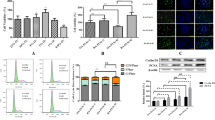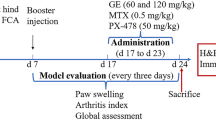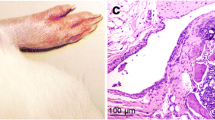Abstract
Background
As the main effector cells of chronic inflammation and hyperplasia of synovium, fibroblast-like synoviocytes (FLSs) show abnormal proliferation and insufficient apoptosis in the hypoxic microenvironment, which is due to the increase of BNIP3-mediated autophagy. This study aimed to explore the mechanism of geniposide (GE) on hypoxia-induced hyper-proliferative FLSs with a focus on autophagy and the JNK-BNIP3 pathway.
Methods
The dynamic changes of autophagy, apoptosis, and hypoxia-related proteins in adjuvant arthritis (AA) rats were detected by immunohistochemistry and Western blot. The proliferation, autophagy, apoptosis, and mitochondrial state of FLSs were detected by CCK-8, flow cytometry, immunofluorescence, and transmission electron microscopy, respectively. Western blot, qRT-PCR, and co-immunoprecipitation were used to detect the expression of the JNK-BNIP3 pathway.
Results
The excessive accumulation of BNIP3 in the synovium of AA rats was accompanied by inhibition of apoptosis and an increase in autophagy. GE inhibited the expression of BNIP3, enhanced apoptosis, decreased autophagy, and improved chronic inflammation and hyperplasia of synovium. The amount of autophagy under different oxygen concentrations was the key to mediating the different survival rates of FLSs, and the inhibition of autophagy triggered apoptosis. GE suppressed the proliferation of FLSs and down-regulated autophagy, leading to the accumulation of ROS and the decrease of mitochondrial membrane potential, induced the increase of apoptosis, and suppressed the accumulation of BNIP3 and the hyperphosphorylation of JNK.
Conclusion
GE inhibited autophagy by restoring the hypoxia-induced activated JNK-BNIP3 pathway, inducing mitochondrial oxidative damage, augmented apoptosis, and decreased survival rate of FLSs.











Similar content being viewed by others
Data availability
All data generated during this study are included in this published article.
References
Xiao C, Lv C, Sun S, Zhao H, Ling H, Li M, et al. TSP1 is the essential domain of SEMA5A involved in pannus formation in rheumatoid arthritis. Rheumatology (Oxford). 2021;60(12):5833–42.
Masoumi M, Bashiri H, Khorramdelazad H, Barzaman K, Hashemi N, Sereshki HA, et al. Destructive roles of fibroblast-like synoviocytes in chronic inflammation and joint damage in rheumatoid arthritis. Inflammation. 2021;44(2):466–79.
Fang J, Chen Z, Lai X, Yin W, Guo Y, Zhang W, et al. Mesenchymal stem cells-derived HIF-1α-overexpressed extracellular vesicles ameliorate hypoxia-induced pancreatic β cell apoptosis and senescence through activating YTHDF1-mediated protective autophagy. Bioorg Chem. 2022;129: 106194.
Li J, Gong SH, He YL, Cao Y, Chen Y, Huang GH, et al. Autophagy is essential for neural stem cell proliferation promoted by hypoxia. Stem Cells. 2023;41: 77.
Hou J, Gao W. IL-27 regulates autophagy in rheumatoid arthritis fibroblast-like synoviocytes via STAT3 signaling. Immunobiology. 2022;227(4): 152241.
Vomero M, Caliste M, Barbati C, Speziali M, Celia AI, Ucci F, et al. Tofacitinib decreases autophagy of fibroblast-like synoviocytes from rheumatoid arthritis patients. Front Pharmacol. 2022;13: 852802.
Yang J, Liu J, Li J, Jing M, Zhang L, Sun M, et al. Celastrol inhibits rheumatoid arthritis by inducing autophagy via inhibition of the PI3K/AKT/mTOR signaling pathway. Int Immunopharmacol. 2022;112: 109241.
Vara-Pérez M, Rossi M, Van den Haute C, Maes H, Sassano ML, Venkataramani V, et al. BNIP3 promotes HIF-1α-driven melanoma growth by curbing intracellular iron homeostasis. EMBO J. 2021;40(10): e106214.
Chen BC, Weng YJ, Shibu MA, Han CK, Chen YS, Shen CY, et al. Estrogen and/or estrogen receptor α inhibits BNIP3-induced apoptosis and autophagy in H9c2 cardiomyoblast cells. Int J Mol Sci. 2018;19(5):1298.
Yao J, Wang J, Xu Y, Guo Q, Sun Y, Liu J, et al. CDK9 inhibition blocks the initiation of PINK1-PRKN-mediated mitophagy by regulating the SIRT1-FOXO3-BNIP3 axis and enhances the therapeutic effects involving mitochondrial dysfunction in hepatocellular carcinoma. Autophagy. 2022;18(8):1879–97.
Deng R, Wang Y, Bu Y, Wu H. BNIP3 mediates the different adaptive responses of fibroblast-like synovial cells to hypoxia in patients with osteoarthritis and rheumatoid arthritis. Mol Med. 2022;28(1):64.
Xiao Y, Ren Q, Zheng Y, Zhang S, Ouyang J, Jiao L, et al. Geniposide ameliorated dexamethasone-induced endoplasmic reticulum stress and mitochondrial apoptosis in osteoblasts. J Ethnopharmacol. 2022;291: 115154.
Wang M, Wu H, Wang R, Dai X, Deng R, Wang Y, et al. Inhibition of sphingosine 1-phosphate (S1P) receptor 1/2/3 ameliorates biological dysfunction in rheumatoid arthritis fibroblast-like synoviocyte MH7A cells through Gαi/Gαs rebalancing. Clin Exp Pharmacol Physiol. 2021;48(8):1080–9.
Wang RH, Dai XJ, Wu H, Wang MD, Deng R, Wang Y, et al. Anti-inflammatory effect of geniposide on regulating the functions of rheumatoid arthritis synovial fibroblasts via inhibiting sphingosine-1-phosphate receptors1/3 coupling Gαi/Gαs conversion. Front Pharmacol. 2020;11: 584176.
Dai MM, Wu H, Li H, Chen J, Chen JY, Hu SL, et al. Effects and mechanisms of Geniposide on rats with adjuvant arthritis. Int Immunopharmacol. 2014;20(1):46–53.
Deng R, Bu Y, Li F, Wu H, Wang Y, Wei W. The interplay between fibroblast-like synovial and vascular endothelial cells leads to angiogenesis via the sphingosine-1-phosphate-induced RhoA-F-Actin and Ras-Erk1/2 pathways and the intervention of geniposide. Phytother Res. 2021;35(9):5305–17.
Wang Y, Wu H, Gui BJ, Liu J, Rong GX, Deng R, et al. Geniposide alleviates VEGF-induced angiogenesis by inhibiting VEGFR2/PKC/ERK1/2-mediated SphK1 translocation. Phytomedicine. 2022;100: 154068.
Laha D, Deb M, Das H. KLF2 (kruppel-like factor 2) regulates osteoclastogenesis by modulating autophagy. Autophagy. 2019;15(12):2063–75.
Touhami S, Béguier F, Yang T, Augustin S, Roubeix C, Blond F, et al. Hypoxia inhibits subretinal inflammation resolution thrombospondin-1 dependently. Int J Mol Sci. 2022;23(2):681.
Gan P, Sun M, Wu H, Ke J, Dong X, Chen F. A novel mechanism for inhibiting proliferation of rheumatoid arthritis fibroblast-like synoviocytes: geniposide suppresses HIF-1α accumulation in the hypoxic microenvironment of synovium. Inflamm Res. 2022;71(10–11):1375–88.
Cizeau J, Ray R, Chen G, Gietz RD, Greenberg AH. The C. elegans orthologue ceBNIP3 interacts with CED-9 and CED-3 but kills through a BH3- and caspase-independent mechanism. Oncogene. 2000;19(48):5453–63.
Zhang Y, Zhou S, Cai W, Han G, Li J, Chen M, et al. Hypoxia/reoxygenation activates the JNK pathway and accelerates synovial senescence. Mol Med Rep. 2020;22(1):265–76.
Tsai CF, Yang SF, Lo CH, Chu HJ, Ueng KC. Role of the ROS-JNK signaling pathway in hypoxia-induced atrial fibrotic responses in HL-1 cardiomyocytes. Int J Mol Sci. 2021;22(6):3249.
Moberg M, Apró W, Horwath O, van Hall G, Blackwood SJ, Katz A. Acute normobaric hypoxia blunts contraction-mediated mTORC1- and JNK-signaling in human skeletal muscle. Acta Physiol (Oxf). 2022;234(2): e13771.
Barbati C, Colasanti T, Vomero M, Ceccarelli F, Celia AI, Perricone C, et al. Up-regulation of autophagy by etanercept treatment results in TNF-induced apoptosis reduction in EA.hy926 endothelial cell line. Clin Exp Rheumatol. 2021;39(3):606–11.
Asadollahi L, Mahoutforoush A, Dorreyatim SS, Soltanfam T, Paiva-Santos AC, Peixoto D, et al. Co-Delivery of erlotinib and resveratrol via nanostructured lipid Carriers: a synergistically promising approach for cell proliferation prevention and ROS-Mediated apoptosis activation. Int J Pharm. 2022;624: 122027.
He G, Nie JJ, Liu X, Ding Z, Luo P, Liu Y, et al. Zinc oxide nanoparticles inhibit osteosarcoma metastasis by downregulating β-catenin via HIF-1α/BNIP3/LC3B-mediated mitophagy pathway. Bioact Mater. 2022;19:690–702.
Li Q, Liu Y, Huang Q, Yi X, Qin F, Zhong Z, et al. Hypoxia acclimation protects against heart failure postacute myocardial infarction via Fundc1-mediated mitophagy. Oxid Med Cell Longev. 2022;2022:8192552.
Zhang F, Luo H, Peng W, Wang L, Wang T, Xie Z, et al. Hypoxic condition induced H3K27me3 modification of the LncRNA Tmem235 promoter thus supporting apoptosis of BMSCs. Apoptosis. 2022;27(9–10):762–77.
Nam JH, Lee JH, Choi HJ, Choi SY, Noh KE, Jung NC, et al. TNF-α induces mitophagy in rheumatoid arthritis synovial fibroblasts, and mitophagy inhibition alleviates synovitis in collagen antibody-induced arthritis. Int J Mol Sci. 2022;23(10):5650.
Zhang J, Zhang C, Jiang X, Li L, Zhang D, Tang D, et al. Involvement of autophagy in hypoxia-BNIP3 signaling to promote epidermal keratinocyte migration. Cell Death Dis. 2019;10(3):234.
Jin Q, Li R, Hu N, Xin T, Zhu P, Hu S, et al. DUSP1 alleviates cardiac ischemia/reperfusion injury by suppressing the Mff-required mitochondrial fission and Bnip3-related mitophagy via the JNK pathways. Redox Biol. 2018;14:576–87.
Wang Y, Wu H, Deng R, Dai XJ, Bu YH, Sun MH, et al. Geniposide downregulates the VEGF/SphK1/S1P pathway and alleviates angiogenesis in rheumatoid arthritis in vivo and in vitro. Phytother Res. 2021;35(8):4347–62.
Di A, Kawamura T, Gao XP, Tang H, Berdyshev E, Vogel SM, et al. A novel function of sphingosine kinase 1 suppression of JNK activity in preventing inflammation and injury. J Biol Chem. 2010;285(21):15848–57.
Li L, Wang H, Zhang J, Sha Y, Wu F, Wen S, et al. SPHK1 deficiency protects mice from acetaminophen-induced ER stress and mitochondrial permeability transition. Cell Death Differ. 2020;27(6):1924–37.
Zhang W, Mottillo EP, Zhao J, Gartung A, VanHecke GC, Lee JF, et al. Adipocyte lipolysis-stimulated interleukin-6 production requires sphingosine kinase 1 activity. J Biol Chem. 2014;289(46):32178–85.
Wang Z, Song T, Guo Z, Cao K, Chen C, Feng Y, et al. Targeting the allosteric pathway that interconnects the core-functional scaffold and the distal phosphorylation sites for specific dephosphorylation of Bcl-2. J Med Chem. 2020;63(22):13733–44.
Bobo C, Céré C, Dufossée M, Dautant A, Moreau V, Manon S, et al. Improved electrophoretic separation to assist the monitoring of Bcl-xl post-translational modifications. Int J Mol Sci. 2019;20(22):5571.
Graham RM, Thompson JW, Wei J, Bishopric NH, Webster KA. Regulation of Bnip3 death pathways by calcium, phosphorylation, and hypoxia-reoxygenation. Antioxid Redox Signal. 2007;9(9):1309–15.
Acknowledgements
This work was supported by the National Natural Science Foundation of China (No 81874360, No 81473400, and No 81073122), the Major Natural Science Research Projects of Anhui Province Colleges and Universities (KJ2021ZD0060), and the Natural Science Research Project of Anhui Educational Committee (2022AH050453).
Author information
Authors and Affiliations
Contributions
RD and HW contributed to the conception and design of the study. RD wrote the first draft of the manuscript. RD, YW, and YH B wrote sections of the manuscript. All authors contributed to the article and approved the submitted version.
Corresponding author
Ethics declarations
Conflict of interest
The authors declare no competing interests.
Additional information
Responsible Editor: John Di Battista.
Publisher's Note
Springer Nature remains neutral with regard to jurisdictional claims in published maps and institutional affiliations.
Rights and permissions
Springer Nature or its licensor (e.g. a society or other partner) holds exclusive rights to this article under a publishing agreement with the author(s) or other rightsholder(s); author self-archiving of the accepted manuscript version of this article is solely governed by the terms of such publishing agreement and applicable law.
About this article
Cite this article
Ran, D., Yan, W., Yanhong, B. et al. Geniposide augments apoptosis in fibroblast-like synoviocytes by restoring hypoxia-enhanced JNK-BNIP3-mediated autophagy. Inflamm. Res. 72, 1745–1760 (2023). https://doi.org/10.1007/s00011-023-01782-4
Received:
Revised:
Accepted:
Published:
Issue Date:
DOI: https://doi.org/10.1007/s00011-023-01782-4




